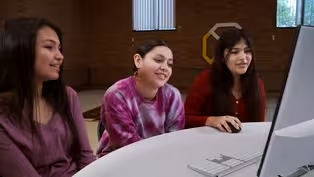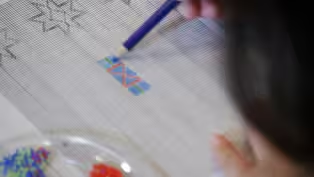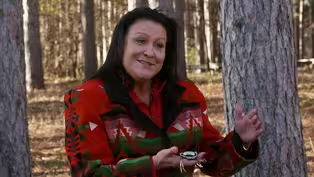SciGirls
Dakota Stars - Mentor Moment 2
Clip: Special | 3m 2sVideo has Closed Captions
The SciGirls talk with mentor, Annette, a Native astrophysicist and artist.
The SciGirls talk with mentor, Annette, a Native astrophysicist and artist.
Problems playing video? | Closed Captioning Feedback
Problems playing video? | Closed Captioning Feedback
SciGirls is a local public television program presented by TPT
SciGirls
Dakota Stars - Mentor Moment 2
Clip: Special | 3m 2sVideo has Closed Captions
The SciGirls talk with mentor, Annette, a Native astrophysicist and artist.
Problems playing video? | Closed Captioning Feedback
How to Watch SciGirls
SciGirls is available to stream on pbs.org and the free PBS App, available on iPhone, Apple TV, Android TV, Android smartphones, Amazon Fire TV, Amazon Fire Tablet, Roku, Samsung Smart TV, and Vizio.
Providing Support for PBS.org
Learn Moreabout PBS online sponsorship♪ ♪ - Today we are meeting Ramona's friend, Annette.
- Let's get ready to meet Annette.
(Sienna) Annette is a Native astrophysicist and artist.
(girls) Hi.
(Annette) Greetings.
Mitakuyé Oyasin.
I greet you with a good heart, all my relations.
My name is Annette Lee.
I am mixed race Lakota.
Our family name is Wanblí Lúta, Red Eagle.
About 15 years ago, I started an organization called Native Skywatchers.
And our vision was to revitalize our star knowledge because so much is lost.
So a lot of people today think of the so-called Greek constellations like that's all there is.
That couldn't be further from the truth.
All the different cultures throughout all of humanity has had this relationship with the sky and the stars.
And in our indigenous way of knowing, it's way more than just labelling, but it's a whole relationship and it's where we come from.
So the purpose of Native Skywatchers was to bring together these pieces of knowledge and these teachings.
- How do you bring your cultural worldview into your work as a scientist?
- One of the things that, uh, we always try to uphold is something called "etuaptmunk."
Etuaptmunk means "two-eyed seeing," and this teaching was shared with me by my friend and colleague, Carola Knockwood, who is from the Mi'kmaq nation over in Cape Breton, Nova Scotia, Canada, and her elders, the Marshalls.
It kind of goes like this: to see with the best in one eye, with the indigenous way of knowing, and then to see with the best in the other eye, with Western science way of knowing.
But this is the key part: to see with both eyes for the benefit of all.
- Two-eyed seeing is similar to living in two worlds because one eye sees the cultural way of learning and then the other eye sees the Westernized way of learning.
And she just put them both together for the benefit of everyone.
- Do you have a suggestion for a science activity that we could do that helps us learn more about the stars?
- There's a lot of really great NASA opportunities.
The ones I'm really interested in and especially excited about have to do with exoplanets and finding other planets right here in our own galaxy.
There's one called Disk Detective that's really good where you're working with actual data from different missions or telescopes or science teams.
- Okay.
We'll try it out.
- Yeah.
It sounds cool.
- Thank you.
- Thank you.
- Bye.
- Bye.
- Keep in touch.
Keep in touch.
- Okay.
We will.
- [speaking Lakota] - It was cool to meet Annette Lee on Zoom.
I wish we could have met her in person, but it was okay.
Video has Closed Captions
Clip: Special | 1m 22s | The SciGirls collaborate on a presentation to share their citizen science project. (1m 22s)
Dakota Stars - Data Collection
Video has Closed Captions
Clip: Special | 2m 21s | The SciGirls search for a citizen science project they can do from home. (2m 21s)
Video has Closed Captions
Clip: Special | 2m 52s | The SciGirls plot out the designs for their constellation beadwork. (2m 52s)
Dakota Stars - Mentor Moment 1
Video has Closed Captions
Clip: Special | 43s | The SciGirls meet their Mentor, Ramona. (43s)
Providing Support for PBS.org
Learn Moreabout PBS online sponsorship
- Science and Nature

Capturing the splendor of the natural world, from the African plains to the Antarctic ice.

- Science and Nature

Explore scientific discoveries on television's most acclaimed science documentary series.












Support for PBS provided by:
SciGirls is a local public television program presented by TPT



